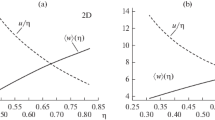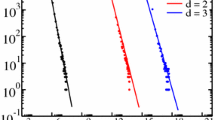Abstract
WE have used an IBM 1130 computer to simulate the very slow settling of rigid equal spheres from a dilute slurry into a randomly packed bed. Settling took place in a box defined by {x,y,z∣0≤x≤20, 0≤y≤20, z≥0}, where the dimensions are given in sphere radii. Initial x and y coordinates of the spheres were chosen by pseudorandom numbers. Once an incoming sphere made its first contact, the process was completely deterministic: the sphere rolled and sometimes fell until it reached a stable position. Thus some spheres rolled all the way from a peak to a valley. Gross wall and end effects were avoided by varying, by means of pseudo-random numbers, the position of walls and floor for each sphere. The final packed bed consisted of 1,561 spheres, but measurements were made on interior spheres only.
Similar content being viewed by others
References
Scott, G. D., Nature, 188, 908 (1960).
Bernal, J. D., and Mason, J., Nature, 188, 910 (1960).
Kuhn, W., Kolloid Z., 68, 2 (1934).
Volkenstein, M. V., Configurational Statistics of Polymeric Chains, High Polymers, 17, 160 (Interscience, 1963).
Author information
Authors and Affiliations
Rights and permissions
About this article
Cite this article
TORY, E., COCHRANE, N. & WADDELL, S. Anisotropy in Simulated Random Packing of Equal Spheres. Nature 220, 1023–1024 (1968). https://doi.org/10.1038/2201023a0
Received:
Revised:
Issue Date:
DOI: https://doi.org/10.1038/2201023a0
- Springer Nature Limited
This article is cited by
-
RSA Simulation of Densification Process with Randomly Packed Cu–Ti Powder Particles Under Pulsating Load
Powder Metallurgy and Metal Ceramics (2022)
-
Powder Compact Structure. Part 3. Theoretical Analysis of Sintering in Powder Compacts with Inhomogeneous Porosity*
Refractories and Industrial Ceramics (2015)
-
Simulated effective elastic moduli and wave velocities in water-saturated sintered glass-beads
Acta Mechanica (1999)
-
Computer simulation of isostatic powder compaction by random packing of monosized particles
Journal of Materials Science Letters (1994)





